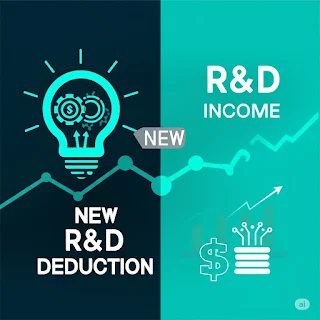The Innovator's Guide to the New R&D Deduction
An interactive tool for U.S. startups and tech businesses to understand and maximize the revived Section 174 immediate R&D expensing rule.
The Big Change: From "Phantom Income" to Immediate Relief
The old rule (TCJA) forced innovators to pay taxes on money they already spent on R&D, creating a "phantom income" crisis. The new law (OBBBA) restores the immediate, 100% deduction for domestic R&D, aligning your tax bill with your actual cash flow.
✗ The Old Way (TCJA 2022-2024)
Required you to capitalize all R&D expenses and write them off slowly over 5 years (for domestic) or 15 years (for foreign). In Year 1, you could only deduct **10%** of your U.S. R&D spend.
Result: Massive, unexpected tax bills that drained cash from startups and small businesses.
✓ The New Way (OBBBA 2025+)
Allows you to deduct **100%** of your domestic R&D expenses in the year you spend the money. Foreign R&D remains on the punishing 15-year schedule.
Result: A dramatic cash-flow boost, elimination of "phantom income" on domestic R&D, and a powerful incentive to innovate in the U.S.
Calculate Your Cash-Flow Impact
Enter your annual U.S. R&D spending to see the difference between the old and new rules.
Your Annual Domestic R&D Spend
Year 1 Deduction (Old Rule)
$25,000
Year 1 Deduction (New Rule)
$250,000
"Phantom Income" Created by Old Rule
$225,000
This is the amount of cash you spent that you couldn't deduct, leading to an artificially high tax bill.
Year 1 Deduction Comparison
What Counts as an R&D Expense?
The definition is broader than you might think. Click each card to see examples of qualifying costs.
Labor Costs
The full compensation package for employees performing, supervising, or directly supporting R&D. This includes salaries, bonuses, stock compensation, payroll taxes, and benefits.
Software Development
All costs for planning, designing, coding, and testing new software or creating significant upgrades and enhancements to existing software.
Contract Research
100% of payments to U.S.-based third parties (freelancers, firms) to perform R&D on your behalf, provided you bear the financial risk and own the results.
Materials & Supplies
Costs of raw materials, components, and other tangible items used and consumed while building and testing prototypes and pilot models.
Overhead & Facilities
A reasonable portion of rent, utilities, insurance, and property taxes for the facility space where your R&D activities take place.
Other Key Costs
Includes patent legal fees, cloud computing costs (e.g., AWS, Azure) for development and testing, and depreciation on equipment used in R&D.
Audit-Proof Your R&D Claim
The burden of proof is on you. A claim is only as strong as its documentation. Use this checklist to prepare.
✓ Project & Technical Docs
- Project plans outlining technical uncertainty
- Design documents, diagrams, schematics
- Test plans, protocols, and results
- Developer logs & meeting notes
- Version control history (e.g., Git logs)
✓ Cost & Financial Docs
- Detailed payroll records by employee
- Contemporaneous time-tracking records
- Invoices for supplies & materials
- Contracts & SOWs for all contractors
- Overhead allocation methodology
Advanced Topics & Official Resources
Dive deeper with these key topics and official IRS links.
The Foreign R&D Penalty: A Major Onshoring Incentive
The new law deliberately kept the harsh 15-year amortization rule for any R&D performed outside the U.S. This creates a massive tax disadvantage for using foreign talent or facilities. For every $100,000 spent on foreign R&D, you can only deduct about $3,333 in Year 1. This makes hiring U.S.-based innovators a powerful strategic and financial decision.
Stacking Benefits: The R&D Tax Credit (Section 41)
Yes, you can and should claim both! The Section 174 deduction reduces your taxable income, while the Section 41 credit directly reduces your final tax bill. For qualifying small startups, the credit can even be claimed against payroll taxes for an immediate cash refund. The expenses that qualify for the credit are a subset of your total Section 174 expenses, so the analyses should be done together.

